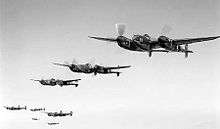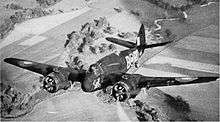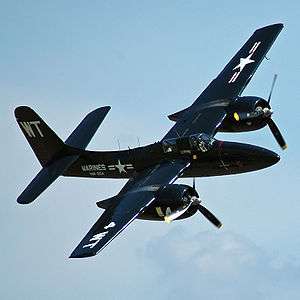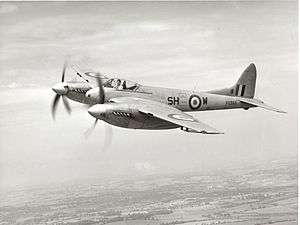Heavy fighter

A heavy fighter is a fighter aircraft designed to carry heavier weapons or operate at longer ranges than light fighter aircraft. To achieve acceptable performance, most heavy fighters were twin-engined, and many had multi-place crews. In Germany, they were known as zerstörer, for "destroyer".
The twin-engine heavy fighter was a major design class during the pre-World War II period, conceived as long-range escort fighters or heavily armed bomber destroyers. Most such designs failed in this mission, they could not maneuver with the more conventional, single-engined fighters and suffered heavy losses. Most notable among such designs was the Messerschmitt Bf 110, which suffered great losses during the Battle of Britain. An exception was the Lockheed P-38 Lightning, which proved to be an effective fighter.
Many twin-engined heavy fighters eventually found their niche as night fighters, fighter-bombers or strike aircraft, with considerable success. Notable among such conversions was the Bf 110, which served as a night fighter for most of the war, and the Bristol Beaufighter, which emerged as a major anti-shipping strike fighter.
Germany

A major heavy fighter design was the Messerschmitt Bf 110, a German fighter that, prior to the war, the Luftwaffe considered more important than their single-engine fighters. Many of the best pilots were assigned to Bf 110 wings, and were specifically designated as Zerstörergeschwader ("destroyer squadron") wings. While lighter fighters were intended for defense, the destroyers were intended for offensive missions: to escort bombers on missions at long range, then use its superior speed to outrun defending fighters that would be capable of outmaneuvering it.[1]
This doctrine proved to be a costly mistake.[2] In practice the Bf 110 was capable of using this combination of features for only a short time, until the late summer of 1940. It served well against the Hawker Hurricane during the Battle of France, but was easily outperformed by – and up to 50 km/h (31 mph) slower in top speed than – the Supermarine Spitfire during the Battle of Britain. Eventually Bf 110s were converted to interceptors, and were particularly successful in the later marks of the Bf 110G series from 1942/3 onwards as night fighters, serving as the primary aircraft of multiple Luftwaffe Nachtjagdgeschwader night fighter wings, using multiple versions of the Lichtenstein radar for nocturnal interception of RAF Bomber Command heavy bombers, as well as finding some use as ground-attack aircraft. The Me 210 and Me 410 Hornisse were all-new aircraft designs meant to replace the Bf 110, but also could not outrun contemporary single-engine fighters, with the Me 210 having serious aerodynamic problems from mistakes in the design of its wing planform and the initial design of its rear fuselage.

Towards the end of the war, the Dornier Do 335 Pfeil could have been an ideal twin-engined Zerstörer fighter design for the Luftwaffe due to its centre line thrust format, which placed its fuselage-mounted twin DB 603 engines' propellers on opposing ends of the fuselage, and potentially allowed much better maneuverability, while essentially using the same engines as the conventional-layout twin engined Me 410. The centre-line thrust design of the Do 335, the first-ever front-line combat fighter to use it, did allow dramatically higher speeds (just over 750 km/h or 465 mph) than any other twin-piston-engined aircraft of its era, but was never produced in quantity.
Following the example set by the Bf 110, the Japanese built the broadly similar Kawasaki Ki-45 Toryu. Likewise neutral Netherlands built the twin-boom Fokker G.I, only to be seized by the Luftwaffe after the German invasion of the Netherlands.
Britain
Perhaps in the belief that "The bomber will always get through", Britain lagged behind in heavy fighter development.[3] Apart from the Westland Whirlwind and the high-altitude Welkin, both built only in modest numbers, the Royal Air Force's wartime heavy fighters were all adapted from earlier bombers. During the Battle of Britain, Bristol Blenheim bombers were fitted, as an interim measure and in utmost secrecy, with radars and ventral gun packs, turning them into the RAF's first night fighters.
More successful was the Bristol Beaufighter, which reused major portions of the earlier Beaufort torpedo bomber. Armed with six .303 inch machine guns, four 20 mm cannon and an assortment of bombs and rockets, the Beaufighter was potent in the anti-ship and ground attack role in the Pacific and Europe. With the addition of radar, it was one of the Royal Air Force's main night fighters. Similarly, the also highly successful de Havilland Mosquito fast bomber was later adapted for both day and night fighter use.
United States

During the late 1930s, Bell Aircraft of the United States designed the YFM-1 Airacuda "bomber destroyer". Very large and heavily armed, the Airacuda was plagued with design flaws; only 13 examples were eventually built, none of which participated in World War II.
The most successful heavy fighter of the war was the Lockheed P-38 Lightning. It was designed to carry heavy armament at high speed or long range. For a variety of reasons, notably its excellent twin turbochargers and its crew of one (rather than two or three), it dramatically outperformed its German, British and Japanese counterparts through crucial periods during the first half of World War II. A complex and advanced design for the early 1940s, the P-38 experienced technical problems in its initial deployments but these issues were solved in subsequent variants and it proved adaptable to undertake multiple roles including fighter escort, reconnaissance (as the F-4 and F-5 variants of which over 1,200 were built), and fighter-bomber. As an escort fighter, the P-38 followed B-17 Flying Fortress raids deep into German-held Europe where it was able to hold its own with smaller and lighter German fighters. The Lightning was the first Allied fighter over Berlin. It was also highly successful in the Pacific theater, where its long range proved a pivotal advantage. By 1944, after drop tanks attained wider usage and newer longer-range fighters such the single-engined P-51D Mustang reached squadrons, the P-38 began to be relegated to roles other than bomber escort or aerial combat. The P-38, however did hold the line during a time in the ETO where they were vastly outnumbered, had no air superiority, and poor tactics were in use. The final P-38L variant of 1944–45 was a superb and capable aircraft, but the other single-engine Allied fighter types on the front line by 1945 were accomplishing many of the same tasks for less in pilot training effort and cost than the relatively more expensive and complex Lightning.
The Grumman F7F Tigercat was the first twin-engined fighter aircraft to enter service with the United States Navy, using two Pratt & Whitney Double Wasp radial engines, achieving a top speed of 460 mph (740 km/h). It was among the fastest piston-engined aircraft ever built, and heavily armed with four 20mm M2 cannon and four 0.50 inch M2 Browning machine guns, with hard points for bombs or a torpedo. Although Grumman designed and developed the aircraft during World War II, it entered service too late to see action before VJ Day. It served in the Korean War and retired in 1954.
After World War II
The last piston-engined heavy fighters to see service were the de Havilland Hornet and its navalised version the Sea Hornet, and the North American F-82 Twin Mustang. All were developed at the end of World War II for use in the Pacific theatre, though none reached operational squadrons until after VJ day, the Hornet in 1946, the Sea Hornet in 1947 and the Twin Mustang in 1948.
Although numerous modern fighters could be called "heavy", with regard to their weight, the term is generally no longer used. As missiles became the standard weapons for air combat any fighter of any size could be successful in combat against almost any target, making the distinction between heavy and light fighters less relevant. However, fifth-generation air dominance and 4th-generation air superiority fighters fulfil an analogous role: they are designed to wrest air superiority from the enemy in hostile territory, and thus usually have greater range than tactical fighters or interceptors. They therefore typically have two engines, and often carry a larger number of air-to-air missiles than their smaller brethren. They typically also have more capable and complex radar and electronic systems, with the result that in older air-superiority fighters such as the McDonnell Douglas F-4 Phantom II or Grumman F-14 Tomcat, a second crew member was also sometimes carried to manage radar and weapon-systems.
See also
References
- ↑ Weal, John (1999). Messerschmitt Bf 110 Zerstörer aces of World War 2. Oxford: Osprey Aviation. pp. 6–7. ISBN 1-85532-753-8.
- ↑ Murphy, Justin D.; McNiece, Matthew A. (2009). Military aircraft, 1919–1945: an illustrated history of their impact (1st ed.). Santa Barbara: ABC-CLIO. ISBN 1-85109-498-9.
- ↑ Mr Baldwin on Aerial Warfare – A Fear For The Future. The Times newspaper, 11 November 1932 p7 column B.


